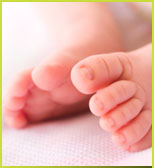| ||||||||||||||||||||||||||||||||||||||||
Welcome to Week 30

Your Baby: Filling Out
Your baby continues to grow taller and fill out as you near the end of your pregnancy. By now, the baby weighs about 3 pounds (1400 g) and measures about 17 inches (38 cm) in total length. Your baby is continuing to grow rapidly now. In preparation for the journey to the new world, baby is taking deep breaths of fluid in the amniotic sac. Sometimes at this point the baby may get hiccups that you can feel!
Your Body: What's Better - Breast Or Bottle?
Chances are you have a lot on your mind as you settle into the last trimester. And like most pregnant women, you're probably pondering what's best for your baby food wise: breast or bottle? Doctors and midwives agree that breastfeeding is the best choice for your baby, and also has significant benefits for your health too. It's best to start out breastfeeding. If you start out bottle-feeding and then want to try breastfeeding, you may find your milk has dried up, and it will be too late. Read on to understand why breastfeeding is such a great option.
Breastfeeding
Breast really is best for many reasons.
- Breast milk has antibodies that help decrease infections and other conditions, reducing your baby's risk of diseases ranging from ear infections to bacterial meningitis.
- Breast milk is specifically tailored to meet your baby's nutritional needs, changing as your baby grows.
- Long term, breastfeeding is associated with a lower risk of insulin-dependent diabetes, lymphoma, and Crohn's disease.
- Breast milk costs nothing.
- It's easier - there's no need to prepare bottles or mix formula.
- Mothers who breastfeed may lose weight more quickly.
- Breastfeeding allows for emotional bonding between you and your baby.
- Babies who are breastfed have higher I.Q.'s.
- Breastfeeding may decrease YOUR chance of developing diabetes later in life.
Keep these things in mind when breastfeeding:
- It's not always easy in the beginning, and takes more effort to learn than bottle feeding. Partners and friends can't pitch in to help with feedings unless you express milk to use in bottles.
- If you plan to go back to work, you'll need to make arrangements to pump milk for your baby throughout the day.
- You'll need to continue to avoid excessive alcohol, and make sure the medicines you take are compatible with breastfeeding.
- It's normal to feel uncomfortable breastfeeding in public places at first. Getting support from your health care providers, your lactation consultant, your family, and even other new moms, can help you overcome any challenges to breastfeeding.
Bottle Feeding
You may think that bottle feeding may be more convenient because others can help feed, but there are a number of downsides:
- Baby does not receive antibodies, and faces a higher risk of infection. Babies who are bottle fed are three times more likely to be hospitalized before their first birthday than babies who are breastfed.
- Formula is expensive.
- You need to set aside time to prepare bottles and mix formula.
- You miss the maternal benefits, such as weight loss, afforded by breastfeeding.
It's best to start out nursing your baby and not use a bottle so you and your baby can figure out how to nurse. After the first few weeks, women who want to both breast and bottle feed often introduce a bottle, so that baby can learn how to feed both ways. If you need to return to work, or be separated from your baby, you can express your milk with a pump and store it for future use. Talk with your health care provider about proper breastmilk storage.
Talk it over with your doctor and your partner and come up with a plan that seems the most reasonable for you, your baby, and your partner.
On a Different Note: The Inner Sanctum
Get a glimpse inside your swelling belly and see how babies grow and change with this ultrasound identifier visual tool. These dynamic images will show you what a fetus looks like at 17, 19, and 30 weeks. Just roll the curser over the different body parts, and presto!
Weekly Tip
If getting comfortable in bed at night is getting more and more difficult, bring on the pillows and props. You can put a maternity pillow (really any pillow will do) between your legs, under your belly, and behind your back. To relieve pressure on your hips from lying on your side, tuck a piece of soft egg-crate foam on top of your mattress and under the sheet, and to ease fluid retention in your legs and ankles, place a folded blanket under your feet to keep them elevated while you sleep.
|
Review Date:
8/20/2019 Reviewed By: LaQuita Martinez, MD, Department of Obstetrics and Gynecology, Emory Johns Creek Hospital, Alpharetta, GA. Also reviewed by David Zieve, MD, MHA, Medical Director, Brenda Conaway, Editorial Director, and the A.D.A.M. Editorial team. |



